Kowloon Walled City
Kowloon Walled City was an ungoverned, densely populated de jure Chinese enclave within the boundaries of Kowloon City, Hong Kong. Originally a Chinese military fort, the walled city became an enclave after the New Territories were leased to the United Kingdom by China in 1898. Its population increased dramatically following the Japanese occupation of Hong Kong during World War II. By 1990, the walled city contained 50,000 residents[1] within its 2.6-hectare (6.4-acre) borders. From the 1950s to the 1970s, it was controlled by local triads and had high rates of prostitution, gambling, and drug abuse.
Kowloon Walled City
九龍城寨 | |
|---|---|
Walled city | |
 An aerial view of the Kowloon Walled City in 1989 | |
 Kowloon Walled City | |
| Coordinates: 22°19′56″N 114°11′25″E | |
| Country/City | China (de facto 1898-1912; de jure; 1898–1993) British Hong Kong (de facto; 1912–1993; sovereignty 1993–1997) |
| District | Kowloon City District |
| Area | Kowloon City |
| Settled | c. 1898 |
| Demolished | 1994 |
| Government | |
| • Type | Ungoverned |
| Area | |
| • Total | 2.6 ha (6.4 acres) |
| Population (1990) | |
| • Total | 50,000 |
| • Density | 1,930,000/km2 (5,000,000/sq mi) |
| Traditional Chinese | 九龍城寨 | ||||||||||||||||
|---|---|---|---|---|---|---|---|---|---|---|---|---|---|---|---|---|---|
| Simplified Chinese | 九龙城寨 | ||||||||||||||||
| |||||||||||||||||
| Original name | |||||||||||||||||
| Traditional Chinese | 九龍寨城 | ||||||||||||||||
| Simplified Chinese | 九龙寨城 | ||||||||||||||||
| |||||||||||||||||
In January 1987, the Hong Kong government announced plans to demolish the walled city. After an arduous eviction process, and the transfer of de jure sovereignty of the enclave from China to Britain, demolition began in March 1993 and was completed in April 1994. Kowloon Walled City Park opened in December 1995 and occupies the area of the former walled city. Some historical artefacts from the walled city, including its yamen building and remnants of its southern gate, have been preserved there.
History
Military outpost
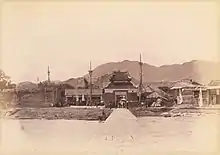
The history of the walled city can be traced back to the Song Dynasty (960–1279), when an outpost was set up to manage the trade of salt. Little took place for hundreds of years afterward, although 30 guards were stationed there in 1668.[2] A small coastal fort was established around 1810 after Chinese forces abandoned Tung Lung Fort.[3] In 1842, during Qing Emperor Daoguang's reign, Hong Kong Island was ceded to Britain by the Treaty of Nanjing. As a result, the Qing authorities felt it necessary to improve the fort in order to rule the area and check further British influence. The improvements, including the formidable defensive wall, were completed in 1847. The walled city was captured by rebels during the Taiping Rebellion in 1854 before being retaken a few weeks later.[2][4] The present walled city's "Dapeng Association House" forms the remnants of what was previously Lai Enjue's garrison.

The Convention for the Extension of Hong Kong Territory of 1898 handed additional parts of Hong Kong (the New Territories) to Britain for 99 years, but excluded the walled city, which at the time had a population of roughly 700. China was allowed to continue to keep officials there as long as they did not interfere with the defence of British Hong Kong. The following year, the governor, Sir Henry Blake, suspected that the viceroy of Canton was using troops to aid resistance to the new arrangements. On 14 April 1899, British forces attacked the walled city, only to find the viceroy's soldiers gone, leaving behind only the mandarin and 150 residents.[2] The Qing dynasty ended its rule in 1912, leaving the walled city to the British.
Though the British claimed ownership of the walled city, they did little with it over the following few decades. The Protestant church established an old people's home in the old "yamen" (Chinese administrative office) as well as a school and an almshouse in other former offices. Aside from such institutions, however, the walled city became a mere curiosity for British colonials and tourists to visit; it was labelled as "Chinese Town" in a 1915 map. In 1933, the Hong Kong authorities announced plans to demolish most of the decaying walled city's buildings, compensating the 436 squatters that lived there with new homes. That same year in 1933, the Nationalist Chinese government protested against the plan, and claimed jurisdiction over the city.[5] The Nationalist Chinese government continued to make claims on its jurisdiction throughout 1935, 1936, and the first half of 1937, until the war between China and Japan started.[6]
By 1940 only the yamen, the school and one house remained. During the World War II occupation of Hong Kong, the Japanese occupying forces demolished the city's wall and used the stone to expand the nearby Kai Tak Airport.[2]
Urban settlement
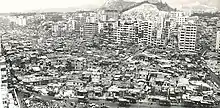
After Japan's surrender in 1945, China announced its intent to reclaim the walled city. In November 1946, Nationalist Chinese officials created the "Draft Outline Plan for Reinstatement of Administration" of the area, which included an office, schools, police, and other functions.[7] Refugees fleeing the Chinese Civil War post-1945 poured into Hong Kong, and 2,000 squatters occupied the walled city by 1947. After a failed attempt to drive them out in 1948, the British adopted a 'hands-off' policy in most matters concerning the walled city.[2] On 8 January 1948, the Nationalist Chinese government sent a memorandum to the British Ambassador, stating "The Ministry of Foreign Affairs now formally declare to the British Embassy that, in accordance with the provisions of the said Convention, the Chinese Government enjoys jurisdiction over the City of Kowloon and that they have no intention whatsoever of renouncing this jurisdiction."[6] The British Foreign Office, on 4 February 1948, considered a variety of solutions (including turning the site into a Nationalist Chinese Consulate-General), and ultimately recommended that the British "accept the principle of Chinese jurisdiction over Kowloon Walled City but the Chinese agree not to attempt to exercise that jurisdiction in practice."[6] Additionally, the British Foreign Office said that "A public garden controlled by the municipal authorities of Kowloon Leased territory offers such a solution and so would a Chinese consular compound, if the Chinese could first be induced to agree in principle to the appointment of a Consul General."[6]
—Leung Ping-kwan, City of Darkness, p. 120[8]
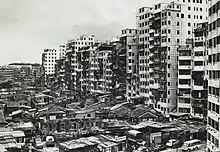
In January 1950, a fire broke out that destroyed over 2,500 huts, home to nearly 3,500 families and 17,000 total people.[9] The disaster highlighted the need for proper fire prevention in the largely wooden-built squatter areas, complicated by the lack of political ties with the colonial and Chinese governments.[10] The ruins gave new arrivals to the walled city the opportunity to build anew, causing speculation that the fire may have been intentionally set.[10][11]
With no government enforcement from the Chinese or the British aside from a few raids by the Royal Hong Kong Police, the walled city became a haven for crime and drugs. It was only during a 1959 trial for a murder that occurred within the walled city that the Hong Kong government was ruled to have jurisdiction there. By that time, however, the walled city was virtually ruled by the organised crime syndicates known as triads.[2]
Beginning in the 1950s, triad groups such as the 14K and Sun Yee On gained a stranglehold on the walled city's numerous brothels, gaming parlours, and opium dens. The walled city had become such a haven for criminals that police would venture into it only in large groups.[12] It was not until 1973 and 1974, when a series of more than 3,500 police raids resulted in over 2,500 arrests and over 1,800 kilograms (4,000 lb) of seized drugs, that the triads' power began to wane. With public support, particularly from younger residents, the continued raids gradually eroded drug use and violent crime. In 1983, the district police commander declared the walled city's crime rate to be under control.[2]

The city also underwent massive construction during the 1960s, with developers building new modular structures above older ones. The city became extremely densely populated and "a world unto its own," an enclave,[13] with over 33,000 people in 300 buildings occupying little more than 7 acres (2.8 ha). As a result, the city reached its maximum size by the late 1970s and early 1980s; a height restriction of 13 to 14 storeys had been imposed on the city due to the flight path of planes heading toward Kai Tak Airport.[14] As well as limiting building height, the proximity of the airport subjected residents to serious noise pollution. Eight municipal pipes provided water to the entire structure, although more could have come from wells.[15] A few of the streets were illuminated by fluorescent lights, as sunlight rarely reached the lower levels due to the outstanding disregard to air rights within the city.[2] Although the rampant crime of earlier decades diminished in later years, the walled city was still known for its high number of unlicensed doctors and dentists who could operate there without threat of prosecution.[16][17]
Although the walled city was for many years a hotbed of criminal activity, most residents were not involved in any crime and lived peacefully within its walls. Numerous small factories and businesses thrived inside the walled city, and some residents formed groups to organise and improve daily life there. [18]An attempt by the government in 1963 to demolish some shacks in a corner of the city gave rise to an "anti-demolition committee" that served as the basis for a kaifong association. Charities, religious societies, and other welfare groups were gradually introduced to the city. While medical clinics and schools went unregulated, the Hong Kong government provided some services such as water supply and mail delivery.[2]
Eviction and demolition
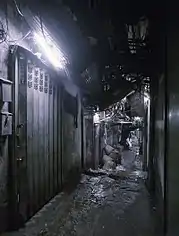
The quality of life in the city—sanitary conditions in particular—remained far behind the rest of Hong Kong. The Sino-British Joint Declaration in 1984 laid the groundwork for the city's demolition.[2] The mutual decision by the two governments to tear down the walled city was announced on 14 January 1987.[19] On 10 March 1987, following the announcement that the walled city would be converted to a park, the Secretary for District Administration formally requested the Urban Council agree to take over the site following demolition. Owing to the presence of numerous other green spaces in the area, the Urban Services Department doubted the need for "yet another park" from a planning and operations point of view, but the council agreed nonetheless to accept the government's proposal on the condition that the government bear the cost of park construction.[20][21]
The government distributed some HK$2.7 billion (US$350 million ) in compensation to the estimated 33,000 residents and businesses in a plan devised by a special committee of the Hong Kong Housing Authority.[22] Some residents were not satisfied with the compensation and were forcibly evicted between November 1991 and July 1992.[23][24] While it was deserted, the empty city was used to film a scene in the 1993 movie Crime Story.[25]
After four months of planning,[26] demolition of the walled city began on 23 March 1993[16] and concluded in April 1994. Construction work on Kowloon Walled City Park started the following month.[27]
Current status as park
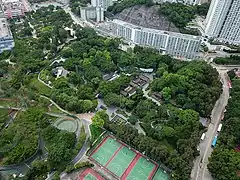
The area where the walled city once stood is now Kowloon Walled City Park, adjacent to Carpenter Road Park.[28] The 31,000 m2 (330,000 sq ft; 7.7 acres) park was completed in August 1995 and handed over to the Urban Council. It was opened officially by Governor Chris Patten a few months later on 22 December.[29] Construction of the park cost a total of HK$76 million .[27]
The park's design is modelled on Jiangnan gardens of the early Qing Dynasty. It is divided into eight landscape features,[27] with the fully restored yamen as its centrepiece. The park's paths and pavilions are named after streets and buildings in the walled city.[30] Artefacts from the walled city, such as five inscribed stones and three old wells, are also on display in the park.[28] The park was designed by the Architectural Services Department, which won a "prestigious award" from the Central Society of Horticulture of Germany for the redevelopment.[31]

Components of the park include:
- The Eight Floral Walks, each named after a different plant or flower[32]
- The Chess Garden, featuring four 3-by-5-metre (9.8 by 16.4 ft) Chinese chessboards[33]
- The Garden of Chinese zodiac, containing stone statues of the 12 Chinese zodiac animals[34]
- The Garden of Four Seasons (named Guangyin Square after the small open area in the walled city), a 300 m2 (3,200 sq ft) garden with plants that symbolise the four seasons[35]
- The Six Arts Terrace, a 600 m2 (6,500 sq ft) wedding area containing a garden and the Bamboo Pavilion[28]
- The Kuixing Pavilion, including a moon gate framed by two stone tablets and the towering Guibi Rock, which represents Hong Kong's return to China[36]
- The Mountain View Pavilion, a two-storey structure resembling a docked boat that provides a good view of the entire park[28][37]
- The Lung Tsun, Yuk Tong, and Lung Nam Pavilions[38]
- The yamen and the remains of the South Gate (see below).
Declared monuments
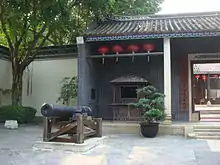
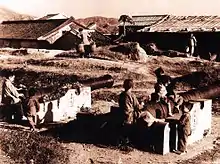
The Antiquities and Monuments Office conducted archaeological examinations as the walled city was being demolished, and several cultural remains were discovered.[39] Among them were the walled city's yamen and remnants of its South Gate, which were officially designated declared monuments of Hong Kong on 4 October 1996.[40]
The South Gate had originally served as the walled city's main entrance. Along with its foundation, other remains included two stone plaques inscribed with "South Gate" and "Kowloon Walled City" from the South Gate and a flagstone path that had led up to it. The foundations of the city's wall and East Gate were also discovered.[27] The Hong Kong government preserved the South Gate remnants next to a square in front of the yamen.[41]
The yamen building is made up of three halls. Originally the middle hall served the Assistant Magistrate of Kowloon's administrative office, and the rear block was his residence. After the government officials left the area in 1899, it was used for several other purposes, including an old people's home, a refuge for widows and orphans, a school, and a clinic. It was restored in 1996 and is now found near the centre of the park.[42] It contains a photo gallery of the walled city, and two cannon dating back to 1802 sit at the sides of its entrance.[30]
Layout and architecture
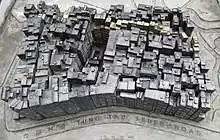
The walled city was located in what became known as the Kowloon City area of Kowloon. In spite of its transformation from a fort into an urban enclave, the walled city retained the same basic layout. The original fort was built on a slope[43] and consisted of a 2.6-hectare (6.4-acre) plot measuring about 210 by 120 metres (690 by 390 ft). The stone wall surrounding it had four entrances and measured 4 metres (13 ft) tall and 4.6 metres (15 ft) thick before it was dismantled in 1943.[3][44]
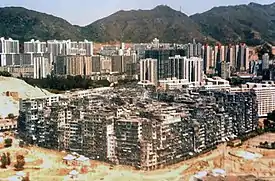
Construction surged dramatically during the 1960s and 1970s, until the formerly low-rise city consisted almost entirely of buildings with 10 storeys or more (with the notable exception of the yamen in its centre).[14][19] However, due to the Kai Tak Airport's position 800 metres (0.50 mi) south of the city, buildings did not exceed 14 storeys.[45] The two-storey Sai Tau Tsuen settlement bordered the walled city to the south and west until it was cleared in 1985 and replaced with Carpenter Road Park.[46][47]
The city's dozens of alleyways were often only 1–2 m (3.3–6.6 ft) wide, and had poor lighting and drainage.[48] An informal network of staircases and passageways also formed on upper levels, which was so extensive that one could travel north to south through the entire City without ever touching solid ground.[14] Construction in the city went unregulated, and most of the roughly 350 buildings were built with poor foundations and few or no utilities.[49] Because apartments were so small—a typical unit was 23 m2 (250 sq ft)—space was maximised with wider upper floors, caged balconies and rooftop additions.[18][19][50] Roofs in the city were full of television antennae, clothes lines, water tanks and rubbish, and could be crossed using a series of ladders.[51][52]
Population
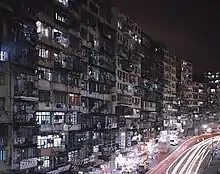
Kowloon Walled City's early population fluctuated between zero and a few hundred, and began growing steadily shortly after World War II. However, there is no accurate population information available for much of the walled city's later existence. Official census numbers estimated the walled city's population at 10,004 in 1971 and 14,617 in 1981, but these figures were commonly considered to be much too low. Informal estimates, on the other hand, often mistakenly included the neighbouring squatter village of Sai Tau Tsuen.[48][53] Population figures of about 50,000 were also reported.[1]
A thorough government survey in 1987 gave a clearer picture: an estimated 33,000 people resided within the walled city. Based on this survey, the walled city had a population density of approximately 1,255,000 inhabitants per square kilometre (3,250,000/sq mi) in 1987,[19] making it the most densely populated spot in the world.[54]
Culture
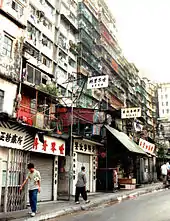
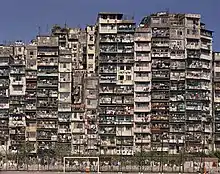
In response to difficult living conditions, residents formed a tightly knit community, helping one another endure various hardships.[55] Within families, wives often did housekeeping, while grandmothers cared for their grandchildren and other children from surrounding households.[56] The city's rooftops were important gathering places, especially for residents who lived on upper floors. Parents used them to relax, and children would play or do homework there after school.[57]
The yamen in the heart of the city was also a major social centre, a place for residents to talk, have tea or watch television, and to take classes such as calligraphy. The Old People's Centre also held religious meetings for Christians and others.[58] Other religious institutions included the Fuk Tak and Tin Hau temples, which were used for a combination of Buddhist, Taoist, and animist practices.[59]
Cultural memory
The absence of an administration, in addition to a physical and psychological isolation from the greater Hong Kong area produced a unique culture of both crime and community, which had only existed within the city.[60]
The widespread criminal activity in the city did not apply exclusively to triads alone; the local police would also conspire with the triads to profit from the illicit trades happening within the city.[61] Both police and residents had spoke of the endemic corruption that was rife within the city[62] However, during the 70s greater police involvement did help to reduce the crime rate, and the city mostly became a haven for people hoping to avoid business regulations and taxes.[18] Thus, the city developed a form of "anarchic urbanism", in which the physical proximity led to a cultural interconnectedness and reliance between community residents, which has contributed to its modern appeal.[62]
While the city was shunned in its early existence, it has now become a point of pride for many Hong Kong residences alike.[46] The rising publicity around Hong Kong following the 1997 handover sparked a re-emergence in the public interest of the Kowloon Walled City and its disappearance, and the cultural memory of the space has become more sanitized, with crime and corruption in the background.[63] In the modern era, the city has begun to be portrayed with a romantic dystopian identity, and many forms of modern media have borrowed the city's culture in their own works.[46] Kowloon Walled City has experienced a 'second life' in which many popular media and game outlets portray the city in a more nostalgic and romanticized version.[62]
Depictions and legacy
Memoirs and autobiographies
A few of the people who spent time in Kowloon Walled City have written accounts of their experiences. Evangelist Jackie Pullinger wrote a 1989 memoir, Crack in the Wall, about her involvement in treating drug addicts within the walled city.[64] In his 2004 autobiography Gweilo, Martin Booth describes his exploration of the walled city as a child in the 1950s.[65] Gordon Jones, a District Officer of Kowloon City District at the time also published his recollections of the city during his time in office.[66]
Books and research papers
- City of Darkness: Life in Kowloon Walled City, by Ian Lambot (writer, photographer) and Greg Girard (photographer), published by Wilhelm Ernst & Sohn, 1993, ISBN 9783433023556 and Watermark, 1999, ISBN 9781873200131
- City of Darkness: Revisited, by Ian Lambot (writer, photographer) and Greg Girard (photographer), published by Watermark, 2014, ISBN 9781873200889 (revised edition of City of Darkness)
- Kyūryūjō Tanbō Makutsu de Kurasu Hitobito: City of Darkness (九龍城探訪 魔窟で暮らす人々 -City of Darkness-, "Kowloon Walled City Exploration: People Who Live in the Devil's Den (City of Darkness)"), by Ian Lambot (writer, photographer) and Greg Girard (photographer), published by EastPress, 2004, ISBN 9784872574234 (Japanese edition of City of Darkness)
- Daizukai Kyūryūjō (大図解九龍城, "Grand Kowloon Walled City Schematics"), by the Kyūryūjō Tankentai (the "Kowloon Walled City Exploration Team"), including Hitomi Terasawa (illustrator), Takayuki Suzuki (architect) and Hiroaki Kani (supervisor), published by Iwanami Shoten, 1997, ISBN 9784000080705
- Kyūryūjōsai (九龍城砦, "Kowloon Walled City"), by Ryūji Miyamoto (photographer), Hiroshi Aramata (text contributor) and Ken'ichi Ōhashi (text contributor), published by Heibonsha, 1997, ISBN 9784582277364; Heibonsha, 1998, ISBN 9784582277364; Heibonsha, 1999, ISBN 9784582277364
- Saigo no Kyūryūjōsai (最期の九龍城砦, "The End of Kowloon Walled City"), by Shintarō Nakamura, published by Shinpusha, 1996, ISBN 9784883066469
- An Architectural Study on the Kowloon Walled City: Preliminary Findings, by Suenn Ho, published by Columbia University, 1992
- Jiulong Cheng Zhai shihua (九龍城寨史話; 'Kowloon Walled City's History'), by Lu Jinzhe, published by Joint Publishing, 1997, ISBN 9789620406829
- 九龍城寨:一個特殊社區的地理透視; 'Kowloon Walled City: A Geographical Perspective of a Special Community', by Wong Kwan-yiu et al., published by the Chinese University of Hong Kong – Department of Geography, 1992
- FARMAX: Excursions on Density, by Winy Maas, Jacob van Rijs and Richard Koek (main contributors), published by 010 Publishers, 1998, ISBN 9789064502668; 010 Publishers, 2006, ISBN 9789064505874
Documentary films
- The Walled City (城寨), as part of Hong Kong Connection's (鏗鏘集) 70th segment, produced by Radio Television Hong Kong (RTHK), 1979
- Hongkongs geheime Stadt – Ein Labyrinth für 50.000 Menschen ("Hong Kong's Secret City: A Labyrinth for 50,000 People"), produced by Österreichischer Rundfunk (ORF), 1989
- Kowloon Walled City, as part of Whicker's World, produced by ITV Yorkshire, 1980
- City of Imagination: Kowloon Walled City 20 Years Later (archive footage by ORF and Suenn Ho), produced by The Wall Street Journal, 2014
Appearance in creative works
Many authors, filmmakers, game designers, and visual artists have used the walled city to convey a sense of oppressive urbanisation or unfettered criminality. In literature, Robert Ludlum's novel The Bourne Supremacy uses the walled city as one of its settings.[67] The City appears as a virtual reality environment (described by Steven Poole as an "oasis of political and creative freedom") in William Gibson's Bridge trilogy.[68][69] In the manga Crying Freeman, the titular character's wife travels to the walled city to master her swordsmanship and control a cursed sword.[70] The manga Blood+: Kowloon Nights uses the walled city as the setting for a series of murders.[71] The walled city finds an extensive mention in Doctor Robin Cook's 1991 novel Vital Signs. The filth, squalor and the crime-oriented nature of the area is described vividly when the characters Marissa and Tristan Williams pass by the back-lanes. The later part of episode 3 and episode 4 of the anime Street Fighter II V are set in the Kowloon Walled City, depicted as a dark and lawless area where Ryu, Ken and Chun-Li have to fight for their lives at every turn, being rescued by the police once they reach the walled city's limits.
The 1982 Shaw Brothers film Brothers from the Walled City is set in Kowloon Walled City.[72] The 1984 gangster film Long Arm of the Law features the walled city as a refuge for gang members before they are gunned down by police.[65] In the 1988 film Bloodsport, starring Jean-Claude Van Damme, the walled city is the setting for a martial arts tournament.[73] The 1992 non-narrative film Baraka features several highly detailed shots of the walled city shortly before its demolition. The 1993 film Crime Story starring Jackie Chan was partly filmed in the deserted walled city, and includes real scenes of building explosions.[25] A walled neighbourhood called the Narrows in the 2005 film Batman Begins was inspired by the walled city.[74] The 2006 Hong Kong horror film Re-cycle features a decrepit, nightmarish version of the walled city, complete with tortured souls from which the protagonist must flee.[75] The 2016 TVB martial arts drama A Fist Within Four Walls takes place in the triad-ridden walled city in the early 1960s.[76]
.jpg.webp)
Kowloon Walled City has been depicted in several games, including Kowloon's Gate[65] and Shenmue II.[77] The game Stranglehold, a sequel to the film Hard Boiled, features a version of the walled city filled with hundreds of Triad members.[77] In the games Fear Effect and Fear Effect 2, photographs of the walled city were used as inspiration "for moods, camera angles and lighting."[78] Concept art for the MMORPG Guild Wars: Factions depicts massive, densely packed structures inspired by the walled city.[79] The pen-and-paper RPG Shadowrun and CRPG Shadowrun: Hong Kong include a crime-ridden, rebuilt version of the Walled City set in 2056.[80] The walled city also features in the 2010 game Call of Duty: Black Ops.[81]
A partial recreation of the Kowloon Walled City existed in the Warehouse Kawasaki, an amusement arcade that operated from 2009 to 2019 in the Japanese suburb of Kawasaki, Kanagawa. The atmosphere of the walled city was reflected in the arcade's narrow corridors, electrical wires, pipes, postboxes, sign boards, neon lights, frayed posters, and various other small touches.[82]
See also
- History of Hong Kong
- Lung Tsun Stone Bridge
- Nan Lian Garden
- Tung Wah Group of Hospitals Museum
- List of buildings and structures in Hong Kong
- List of urban public parks and gardens of Hong Kong
- Terra nullius
- Bir Tawil; Hala'ib Triangle
- Centro Financiero Confinanzas, an abandoned skyscraper populated in a similar manner
- Ras Khamis, a neighborhood in East Jerusalem that also has unplanned highrise construction due to uncertain political jurisdiction
- Dharavi, a densely populated community within Mumbai which has developed a similar localized economy and unplanned infrastructure system.
References
Citations
- Nosowitz, Dan (18 April 2013). "Life Inside The Most Densely Populated Place on Earth [Infographic]". Popular Science. Popular Science. Retrieved 13 April 2018.
1990 50,000 inhabitants
- Wilkinson, Julia (1993). "A Chinese Magistrate's Fort". City of Darkness: Life in Kowloon Walled City. pp. 60–71. ISBN 978-1-8732-0013-1.
- Sinn, Elizabeth. "Kowloon Walled City: Its Origin and Early History" (PDF). Journal of the Hong Kong Branch of the Royal Asiatic Society. 27: 30–31. Archived from the original (PDF) on 30 April 2011. Retrieved 25 November 2009.
- Li Long Lam, Excavation Report of Kowloon Walled City, Hong Kong(香港九龙寨城发掘简报)", in Kaogu, vol. 6, 2007.
- Miners, N. J. (1982). "A Tale of Two Walled Cities: Kowloon and Weihaiwei". Hong Kong Law Journal. 12: 179.
- Britain and China 1945–1950: Documents on British Policy Overseas, Series I, Volume 8, S.R. Ashton, G. Bennett, K. Hamilton, Routledge, 2013 page 127
- "The History of Planning for Kowloon City" (PDF). Planning Perspective.
- Kwan, Leung Ping. "The Walled City: Our Place". City of Darkness: Life in Kowloon Walled City. pp. 120–23.
- Smart 2006, p. 59
- Smart 2006, pp. 65–67
- Booth, Martin (14 November 2006). Golden Boy: Memories of a Hong Kong Childhood. St. Martin's Press. p. 131. ISBN 978-1-4668-1858-3.
- Carney, John (16 March 2013). "Kowloon Walled City: Life in the City of Darkness". South China Morning Post. Retrieved 29 January 2014.
- Harter, Seth (November 2000). "Hong Kong's Dirty Little Secret". Journal of Urban History. 27 (1): 92–113. doi:10.1177/009614420002700106. ISSN 0096-1442. S2CID 145574313.
- Lambot 2007, p. 48
- Goddard, Charles (September 2007). "The Water Supply". City of Darkness: Life in Kowloon Walled City. pp. 36–38.
- Vines, Stephen (24 March 1993). "Demolition begins on HK's Walled City". The Business Times. Singapore. p. 4. Retrieved 25 November 2009. (subscription required)
- Wall Street Journal (2 April 2014), City of Imagination: Kowloon Walled City 20 Years Later, retrieved 8 March 2019
- Basler, Barbara (16 June 1992). "The Walled City, Home to Huddled Masses, Falls". The New York Times. p. A4. Retrieved 27 November 2009.
- Goddard, Charles. "The Clearance". City of Darkness: Life in Kowloon Walled City. pp. 208–11.
- "Memorandum for Members of the Recreation Select Committee, Capital Works Select Committee, Finance Select Committee, and the Standing Committee of the Whole Council: Proposed Park at the site of Kowloon Walled City 10 April 1987". Urban Council.
- "Memorandum for Members of the Recreation Select Committee: Proposed Park Development at The Kowloon Walled City Site 7 September 1990". Urban Council.
- Lau, Esme (10 December 1987). "$2.7 billion package for residents of Walled City" (PDF). The Hong Kong Standard. (subscription required)
- "Families evicted from slum city". The Toronto Star. 28 November 1991. p. A3. Retrieved 25 November 2009. (subscription required)
- Jonathan, Braude (3 July 1992). "Last squatters evicted in Kowloon". The Times. Retrieved 25 November 2009. (subscription required)
- Strother, Barbara. "Kowloon Walled City Park Information". Home & Abroad. Archived from the original on 22 July 2011. Retrieved 27 October 2009.
- Kang-Chung, Ng (19 March 1993). "Work to start on slum area". The South China Morning Post. China. p. 4. Retrieved 25 November 2009. (subscription required)
- "Kowloon Walled City Park – History/Background". Leisure and Cultural Services Department. 21 October 2004. Archived from the original on 7 February 2010. Retrieved 6 November 2009.
- "Location Database". Film Services Office. 1 June 2009. Retrieved 18 November 2009.
- Flint, John (23 December 1995). "Walled City's transformation sparks hopes for other sites". South China Morning Post. Retrieved 28 January 2014.
- "The Yamen". Leisure and Cultural Services Department. 21 October 2004. Archived from the original on 23 November 2009. Retrieved 17 November 2009.
- Ng, Kang-Chung (12 January 1994). "Walled City park project wins top award". South China Morning Post.
- "Eight Floral Walks". Leisure and Cultural Services Department. 21 October 2004. Archived from the original on 13 November 2009. Retrieved 16 November 2009.
- "The Chess Garden". Leisure and Cultural Services Department. 21 October 2004. Archived from the original on 1 November 2009. Retrieved 16 November 2009.
- "The Garden of Chinese Zodiac". Leisure and Cultural Services Department. 21 October 2004. Archived from the original on 13 November 2009. Retrieved 16 November 2009.
- "The Garden of Four Seasons". Leisure and Cultural Services Department. 21 October 2004. Archived from the original on 13 November 2009. Retrieved 16 November 2009.
- "Kuixing Pavilion and Guibi Rock". Leisure and Cultural Services Department. 21 October 2004. Archived from the original on 13 November 2009. Retrieved 16 November 2009.
- "The Mountain View Pavilion". Leisure and Cultural Services Department. 21 October 2004. Archived from the original on 25 November 2009. Retrieved 16 November 2009.
- "Layout Plan". Leisure and Cultural Services Department. 21 October 2004. Archived from the original on 23 November 2009. Retrieved 19 November 2009.
- "The Geographical Information System on Hong Kong Heritage". Leisure and Cultural Services Department. Archived from the original on 12 November 2014. Retrieved 19 November 2009.
- "Annex I Listing of Declared Monuments". Environmental Protection Department. 28 April 2006. Archived from the original on 28 December 2009. Retrieved 6 November 2009.
- "The Old South Gate". Leisure and Cultural Services Department. 21 October 2004. Archived from the original on 24 November 2009. Retrieved 19 November 2009.
- "Former Yamen Building of Kowloon Walled City, Kowloon Walled City Park". Leisure and Cultural Services Department. 5 February 2009. Archived from the original on 3 November 2009. Retrieved 22 October 2009.
- Lambot 2007, p. 18
- Benedetti, Paul (18 September 1982). "A nervy tour of Kowloon's Walled City". The Globe and Mail. Retrieved 27 November 2009. (subscription required)
- Lambot 2007, p. 206
- Girard, Greg. "Foreword". City of Darkness: Life in Kowloon Walled City. p. 7.
- Lambot 2007, p. 71
- Wesley-Smith, Peter (1998). Unequal treaty, 1898–1997: China, Great Britain, and Hong Kong's new territories (rev. ed.). Hong Kong: Oxford University Press. pp. 189–90. ISBN 0-19-590354-4.
- Lambot 2007, pp. 48, 74, 79
- Lambot 2007, pp. 34, 199
- Popham, Peter. "Introduction". City of Darkness: Life in Kowloon Walled City. pp. 9–13.
- Lambot 2007, pp. 199, 203
- Siu-Fong, Betty Ho (1986). Redevelopment of Kowloon Walled City: A Feasibility Study (PDF). University of Hong Kong. p. 52. OCLC 52017240. Archived from the original (PDF) on 10 March 2014. Retrieved 11 March 2014.
- "17 Most Densely Populated Places on Earth". kickassfacts.com. 26 October 2013.
- Lambot 2007, p. 122
- Lambot 2007, pp. 115, 154
- Lambot 2007, pp. 203–204
- Lambot 2007, p. 132
- Lambot 2007, pp. 26, 139
- Lee, Jung Joon (2016). "Kowloon Walled City Revisited: Photography and Postcoloniality in the City of Darkness". Trans Asia Photography. 6: 1.
- Ho, Lawrence (2012). "Un-Forgetting walls by lines on maps: A case study on property rights, cadastral mapping, and the landscape of the Kowloon Walled City". Land Use Policy: 94–102 – via JSTOR.
- Fraser, Alistair (2017). "The second life of Kowloon Walled City: Crime, Media and cultural memory". Crime, Media, Culture. 12 (2): 217–234. doi:10.1177/1741659017703681. PMC 5732597. PMID 29278247.
- Ackbar, Abbas (1997). Hong Kong: Culture and the Politics of Disappearance. University of Minnesota Press. pp. 1–15. ISBN 978-0-8166-8798-5.
- Pullinger, Jackie; Danziger, Nick (1 May 1989). Crack in the Wall. Hodder & Stoughton Religious. ISBN 978-0-340-49067-9.
- McDonogh, Gary; Wong, Cindy (30 August 2005). Global Hong Kong. Routledge. pp. 27–28. ISBN 978-0-415-94770-1.
- Jones, Gordon (2011). "The Kowloon City District and the Clearance of the Kowloon Walled City: Personal Recollections" (PDF). Journal of the Royal Asiatic Society Hong Kong Branch. 51: 257–278. ISSN 1991-7295. JSTOR 23891943.
- Ludlum, Robert (March 1987). The Bourne Supremacy. Bantam Books. ISBN 0-553-26322-6.
- Poole, Steven (3 May 2009). "Tomorrow's man". The Guardian. London. Retrieved 15 October 2009.
- Gibson, William (September–October 1993). "Disneyland with the Death Penalty". Wired. Condé Nast. 1 (4). Archived from the original on 2 February 2021. Retrieved 16 November 2009.
- Bartholow, Michael (4 October 2006). "Crying Freeman Volume 3 TPB". Advanced Media Network. Retrieved 26 October 2009.
- "Blood+: Kowloon Nights". Dark Horse Comics. Retrieved 26 October 2009.
- "Review of Brothers from the Walled City". Sogoodreviews.com. Retrieved 11 March 2014.
- "New Age Timeout". BD: New Age. 19 May 2005. Archived from the original on 20 June 2008. Retrieved 21 October 2009.
- Otto, Jeff (6 June 2005). "Interview: Christopher Nolan". IGN. Archived from the original on 31 March 2012. Retrieved 15 October 2009.
- Shingleton, Matt (12 September 2006). "Re-Cycle". The DVD Times. Retrieved 17 October 2009.
- TVB 周刊 #950 新劇解構" [TVB Weekly, #950; New drama explained]. TVB Weekly (in Chinese). TVB. 7 September 2015.
- McMillan, Fraser (7 September 2009). "Stranglehold". Thunderbolt. Archived from the original on 22 July 2012. Retrieved 24 October 2009.
- Lui, Chi Kong (4 April 2001). "Interview with Stan Liu – Part 1". Game Critics. Retrieved 24 October 2009.
- "ArenaNet Art Director Daniel Dociu wins Spectrum 14 gold medal!". Guild Wars. 9 March 2007. Retrieved 24 October 2009.
- Boyle, Rob (17 July 2006). Shadowrun: Runner Havens. Fanpro. pp. 13, 26. ISBN 978-1-932564-68-6. Archived from the original on 23 January 2009. Retrieved 17 October 2009.
- Young, Michelle (10 February 2011). "The Lost Kowloon Walled City in Hong Kong as Represented in Video Games". Untapped Cities. Retrieved 18 August 2019.
- Ryall, Julian (1 October 2013). "Arcade brings Kowloon Walled City back from the dead... in Japan". South China Morning Post. Retrieved 27 April 2014.
Sources
- Lambot, Ian (September 2007). City of Darkness: Life in Kowloon Walled City. Watermark. ISBN 978-1-873200-13-1.
- Smart, Alan (1 June 2006). The Shek Kip Mei Myth: Squatters, Fires and Colonial Rule in Hong Kong, 1950–1963. Hong Kong University Press. ISBN 978-962-209-792-6.
External links
| External media | |
|---|---|
| Images | |
| Video | |
- Unofficial analyses:
- A team's exploration of the City before demolition
- Historical, architectural and political overview
- Kowloon Walled City life (South China Morning Post article)
- Kowloon Walled City project, Wall Street Journal
- Rare Maps Show Life in Hong Kong's Vice-Filled 'Walled City'
- “Dark tower of dreams: Inside the Walled City of Kowloon”, CBC Ideas. CBC Radio One. 18 October 2017. (Retrieved 12 July 2018.)